Psychology > QUESTIONS & ANSWERS > Research Paper > 003 Aboriginal and/ or Torres Strait Islander Cultural Identity (All)
Research Paper > 003 Aboriginal and/ or Torres Strait Islander Cultural Identity
Document Content and Description Below
003 Aboriginal and/ or Torres Strait Islander Cultural Identity 003 Aboriginal and/ or Torres Strait Islander Cultural Identity CHCECE001 Develop cultural competence and CHCDIV002 Promote... Aboriginal and/ or Torres Strait Islander cultural safety CHCECE001 Develop cultural competence Element 1 Reflect on own cultural identity and biases Element 2 Identify and develop cultural competency Element 3 Research Aboriginal and/or Torres Strait Islander communities Element 4 Support individual cultural identities Element 5 Create environments to support children’s cross-cultural understanding and relationships Element 6 Support the implementation of inclusive learning experiences Element 7 Support children in developing confidence and strength in personal and cultural identity Performance Evidence Knowledge Evidence CHCDIV002 Promote Aboriginal and/or Torres Strait Islander cultural safety Element 1 Identify cultural safety issues in the workplace Element 2 Model cultural safety in own work Element 3 Develop strategies for improved cultural safety Performance Evidence Knowledge Evidence Question 1 To complete this task refer to (pp.1 - 11) of your reading: · Aboriginal and Torres Strait Islander: Social and Emotional Wellbeing. a) How are Aboriginal and Torres Strait Islander people defined? b) List the three key factors that should be considered when exploring concepts of Aboriginal and Torres Strait Islander wellbeing. a) Provide an example for each of the following impacts on the Aboriginal and Torres Strait Islander people due to the European settlement. Reference: Aboriginal and Torres Strait Islander: Social and Emotional Wellbeing. Page 1 a) Living in situations of homelessness, poverty or unemployment increases the severity of physical and mental illnesses. List four factors which contribute to the increase of physical and mental illness of Aboriginal and/or Torres Strait Islander individuals and communities? a) List three factors that contribute to Aboriginal and/or Torres Strait Islander children being at high risk of emotional or behavioural difficulties? a) Give two examples of taboos or traditions of Aboriginal and/or Torres Strait Islander people that may be different from non-Aboriginal and/or Torres Strait Islander people. Question 2 To complete this task refer to (pp.1 – 6) of your reading: · Australia – A national overview. Bringing Them Home. a) How long have Aboriginal people and their ancestors occupied Australia? b) What is the significance of the European doctrine of terra nullius in relation early colonisation and Aboriginal Land Rights? c) What were the two key policies adopted by the British Select Committee in relation to the bad treatment of Aboriginal people in Australia? a) What laws and systems were put in place as a result of these policies? a) What two powers were given to the Chief Protectors? a) By the turn of the century what did the government see as a solution to ‘the Aboriginal Problem’? b) During the 1920’s children were separated from their families and communities. Where were they sent to and what was the impact on their living conditions, schooling/education, language and discipline? c) During the 50’s and 60’s how did child welfare services respond to the increasing numbers of children being removed from their families? d) What were the two outcomes of the 1967 constitutional referendum for Aboriginal people? e) What are the three key features of self-determination? a) List the nine significant changes to the way Indigenous people were viewed by non-Indigenous during the 1990’s. Question 3 To complete this task refer to (pp. 9 – 17) of your reading: · Working with Aboriginal People and Communities – A Practice Resource. Explain the symbolism of the Aboriginal flag. a) Explain the symbolism of the Torres Strait Islander flag. a) List the two ways Aboriginal people refer to themselves and their mob. a) Explain how the concept of ‘community as family’ is reflected in relation to the responsiblity for raising, caring, educating and disciplining children in Aboriginal communities. b) Among Aboriginal people what nine factors is the extended family structure based on? a) In Aboriginal communities what roles are defined by kinship? b) Aboriginal people are the original owners of the land and this special position is recognised as Welcome to Country. What does the Welcome to Country enable the community to do? c) Who is able to perform a Welcome to Country? d) Explain the concept of Men’s and Women’s Business. e) In an EC service there should be respect for Men’s and Women’s Business. List three practice tips that the EC service can use to demonstrate respect? a) What are the senstivities around death that should be observed with Aboriginal people? b) What term is often used by Aboriginal people when refering to a death? c) What term is often used as a sign of respect by Aboriginal people when refering to Elders? Question 4 To complete this task refer to (p. 1) of your reading: · Difference between Aboriginal and Torres Strait Islanders. List the key differences between Aboriginal and Torres Strait Islanders. Question 5 To complete this task refer to the following website: · NAIDOC: http://www.naidoc.org.au/about a) What is the purpose of NAIDOC Week? b) List five ways in which a children’s service could participate in NAIDOC Week. a) List five NAIDOC Week awards categories. Question 6 To complete this task refer to the following website: · National Aboriginal and Torres Strait Islander Children’s Day:http://aboriginalchildrensday.com.au/ National Aboriginal and Torres Strait Islander Children’s Day is celebrated on 4th August each year. What is the focus of this celebration? Question 7 To complete this task refer to the following website: · Timeanddate.com: http://www.timeanddate.com/holidays/australia/national-sorry-day What is the purpose of National Sorry Day, observed on 26th May each year? 004 Aboriginal and/ or Torres Strait Islander Cultural Realities CHCECE001 Develop cultural competence and CHCDIV002 Promote Aboriginal and/ or Torres Strait Islander cultural safety CHCECE001 Develop cultural competence Element 1 Reflect on own cultural identity and biases Element 2 Identify and develop cultural competency Element 3 Research Aboriginal and/or Torres Strait Islander communities Element 4 Support individual cultural identities Element 5 Create environments to support children’s cross-cultural understanding and relationships Element 6 Support the implementation of inclusive learning experiences Element 7 Support children in developing confidence and strength in personal and cultural identity Performance Evidence Knowledge Evidence CHCDIV002 Promote Aboriginal and/or Torres Strait Islander cultural safety Element 1 Identify cultural safety issues in the workplace Element 2 Model cultural safety in own work Element 3 Develop strategies for improved cultural safety Element 4 Evaluate cultural safety strategies Performance Evidence Knowledge Evidence Question 1 To complete this task refer to your reading: · What is cultural safety? a) What is the definition of cultural safety? b) What does cultural safety mean for Aboriginal and Torres Strait Islander children? Question 2 To complete this task refer to (pp. 2 – 14) of your reading: · Aboriginal and Torres Strait Islander Children’s Cultural Needs. a) In relation to Aboriginal and Torres Strait Islander culture list the six elements of the domains of cultural needs. a) Provide six examples of ‘Personal Identity’ as a cultural need. a) How is the belief in relation to ‘country’ described? b) What learning opportunity is provided to Aboriginal and/or Torres Strait Islander children when they have a connection to their land and/or water? c) What are four key benefits of cultural expression for Aboriginal and/or Torres Strait Islander children? a) List four practical ways in which Aboriginal and Torres Strait Islander culture is celebrated. Question 3 To complete this task refer to (pp. 242 – 244) of your textbook ‘The Big Picture’. a) List five factors which demonstrate that young Aboriginal and/or Torres Strait Islander children and infants have poorer life outcomes than non - Aboriginal and Torres Strait Islander children. a) List five key barriers for Aboriginal and/or Torres Strait Islander people to accessing children’s education and care services? Question 4 To complete this task refer to (pp.17 – 18) of your reading: · Aboriginal Cultural Competence Framework - Culture and the child and family services system. The Victorian Aboriginal Cultural Competence Framework states that maintenance of culture is a key goal for Aboriginal communities in relation to the education of their children. List the five key beliefs in relation to this goal. Question 5 To complete this task refer to (p. 9) of your reading: · Cultural Connections Booklet - How do my biases affect the children I work with? Explain the meaning of each of the following responses to discrimination. Question 6 To complete this task refer to (pp. 11 – 12) of your reading: · Cultural Connections Booklet - Helpful tips in challenging discriminatory or bias comments from children. List and describe six ways in which educators can challenge discriminatory or bias comments from children. 005 Inclusion in the Workplace CHCECE001 Develop cultural competence and CHCDIV002 Promote Aboriginal and/ or Torres Strait Islander cultural safety CHCECE001 Develop cultural competence Element 1 Reflect on own cultural identity and biases Element 2 Identify and develop cultural competency Element 3 Research Aboriginal and/or Torres Strait Islander communities Element 4 Support individual cultural identities Element 5 Create environments to support children’s cross-cultural understanding and relationships Element 6 Support the implementation of inclusive learning experiences Element 7 Support children in developing confidence and strength in personal and cultural identity Performance Evidence Knowledge Evidence CHCDIV002 Promote Aboriginal and/or Torres Strait Islander cultural safety Element 1 Identify cultural safety issues in the workplace Element 2 Model cultural safety in own work Element 3 Develop strategies for improved cultural safety Element 4 Evaluate cultural safety strategies Knowledge Evidence Question 1 To complete this task refer to (p. 3) of your reading: · ECA Code of Ethics. What does the ECA Code of Ethics state in relation to cultural diversity and/or inclusion for each of the following groups? Question 2 To complete this task refer to (p. 27) of your reading: · Belonging, Being and Becoming: The Early Years Learning Framework for Australia. Describe six ways an educator can promote learning in relation to EYLF Outcome 2 Children are connected with and contribute to their world? Educators promote this learning when they: Question 3 Reflect and draw on the knowledge you have acquired from the text and readings in this unit to answer the following questions. a) What message of cultural safety is the Director sending to the community by employing Aboriginal trainees? b) List the key protocals that the Director used when employing the trainees. Question 4 Reflect and draw on the knowledge you have acquired from the text and readings in this unit to answer the following questions. a) Give three reasons why the Director is right to be concerned about the comments made by Jack and Kate? a) What could the Director do to assist Jack and Kate to understand the importance of Sorry Day for Norah, her community and all Australians? Question 5 Reflect and draw on the knowledge you have acquired from the text and readings in this unit to answer the following question. Explain why the above scenario is a positive example of how Aboriginal and/or Torres Strait Islander culture can be effectively communicated and integrated into the daily program. Question 6 To complete this task refer to (p. 249) of your textbook ‘The Big Picture’. List six ways the Aboriginal and/or Torres Strait Islander culture can be integrated across the curriculum. 006 Communicate Effectively CHCECE001 Develop cultural competence and CHCDIV002 Promote Aboriginal and/ or Torres Strait Islander cultural safety CHCECE001 Develop cultural competence Element 2 Identify and develop cultural competency Element 3 Research Aboriginal and/or Torres Strait Islander communities Element 4 Support individual cultural identities Performance Evidence Knowledge Evidence CHCDIV002 Promote Aboriginal and/or Torres Strait Islander cultural safety Element 1 Identify cultural safety issues in the workplace Element 2 Model cultural safety in own work Element 3 Develop strategies for improved cultural safety Element 4 Evaluate cultural safety strategies Knowledge Evidence Question 1 To complete this task refer to (pp. 5 – 36) of your reading: · Cultural Connections Booklet - ‘‘Communicating with Others’. a) List two practical suggestions provided in relation to connecting with others ‘on a human level’. a) How would you respond to someone who tells you that all Aboriginal communities are the same (homogeneous)? b) How can services show sensitivity to parents who may have poor literacy skills? Question 2 To complete this task refer to (p. 21) of your reading: · Working with Aboriginal People and Communities – A Practice Resource. List the two key facts in relation to Aboriginal language and dialects. Question 3 To complete this task refer to (pp. 1 – 2) of your reading: · Protocols: Communicating with Aboriginal and Torres Strait Islander People. a) What is the traditional meaning of an Aboriginal Elder? b) How is the term ‘Mob’ used by Aboriginal people? c) Who is a ‘Traditional owner’? d) List six terms that are considered to be offensive when communicating withAboriginal people. Question 4 To complete this task refer to (pp. 2 – 3) of your reading: · Protocols: Communicating with Aboriginal and Torres Strait Islander People. List the ways in which communication barriers can be overcome in each of the following areas. Reference: Protocols: Communicating with Aboriginal and Torres Strait Islander People. Page 2-3 Question 5 To complete this task refer to (pp. 21 – 22) of your reading: · Using Translating and Interpreting Services in Early Childhood Services. a) What is the difference between interpreters and translators? b) When should a professional interpreter be used? a) When may a non-professional interpreter, such as relatives or friends be used? b) What are the issues around the use of a non-professional interpreter? c) How can services access translating and interpreter services? 007 Anti-Bias CHCECE001 Develop cultural competence and CHCDIV002 Promote Aboriginal and/ or Torres Strait Islander cultural safety CHCECE001 Develop cultural competence Element 2 Identify and develop cultural competency Element 4 Support individual cultural identities Element 5 Create environments to support children’s cross-cultural understanding and relationships Element 6 Support the implementation of inclusive learning experiences Element 7 Support children in developing confidence and strength in personal and cultural identity Performance Evidence Knowledge Evidence CHCDIV002 Promote Aboriginal and/or Torres Strait Islander cultural safety Element 2 Model cultural safety in own work Question 1 To complete this task refer to the Glossary (pp. 409) of your textbook ‘The Big Picture’. Explain the meaning of each of the following terms. | Term | Explain the meaning | Racism | | Bias | | Bigotry | Question 2 To complete this task refer to (pp. 254) of your textbook ‘The Big Picture’. a) Explain the principles of anti-bias education. b) How does exploration of differences and similarities support children to feel safe and comfortable with differences? c) According to Derman-Sparks & Olsen Edwards, (2010) what are the four goals of anti-bias education? Question 3 To complete this task refer to (pp. 255-256) of your textbook ‘The Big Picture’. Explain why educators should respond to bias in the following ways: Reference: ‘The Big Picture’. Page 256 Question 4 Reflect and draw on the knowledge you have acquired from the text and readings in this unit to answer the following question. Using the strategies below identify how the educator could address the bias in each scenario. Strategies: Select three strategies educators can use to address the bias in this scenario. Question 5 To complete this task refer to your reading: · Planning for a Multicultural Child Care Environment Checklist. Using the Checklist as a guide, suggest three things that the educators could add to reflect a more multicultural environment. a) Dramatic Play. a) Block Area. a) Games and Puzzles. Reference: Planning for a Multicultural Child Care Environment Checklist. Page 1-2 Question 6 Reflect and draw on the knowledge you have acquired from the text and readings in this unit to answer the following question. Based on the feedback from the Elder list two strategies the team could put in place to embed and celebrate Aboriginal and Torres Strait Islander Culture within their program. [Show More]
Last updated: 1 year ago
Preview 1 out of 33 pages
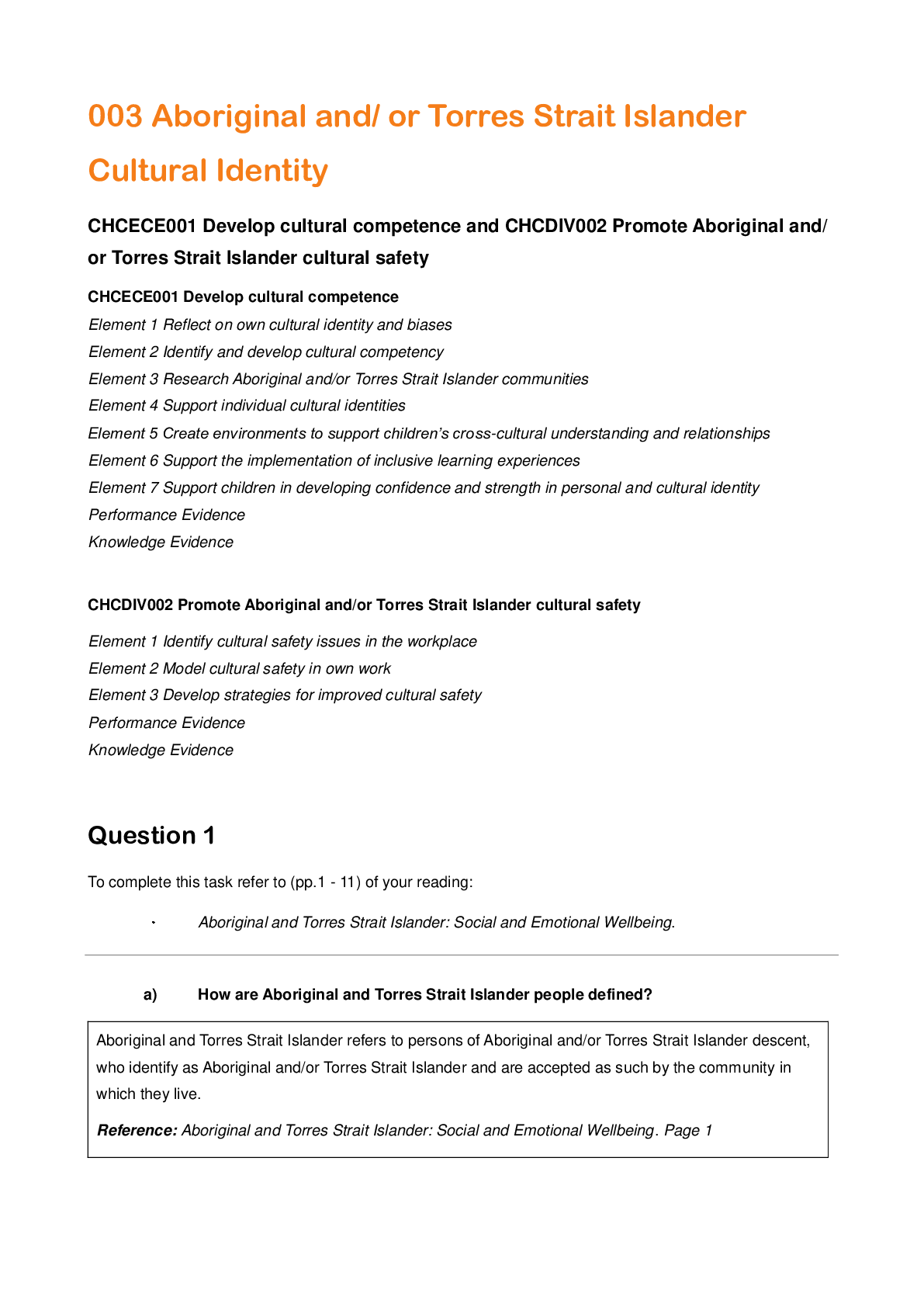
Reviews( 0 )
Document information
Connected school, study & course
About the document
Uploaded On
Jan 10, 2021
Number of pages
33
Written in
Additional information
This document has been written for:
Uploaded
Jan 10, 2021
Downloads
0
Views
46







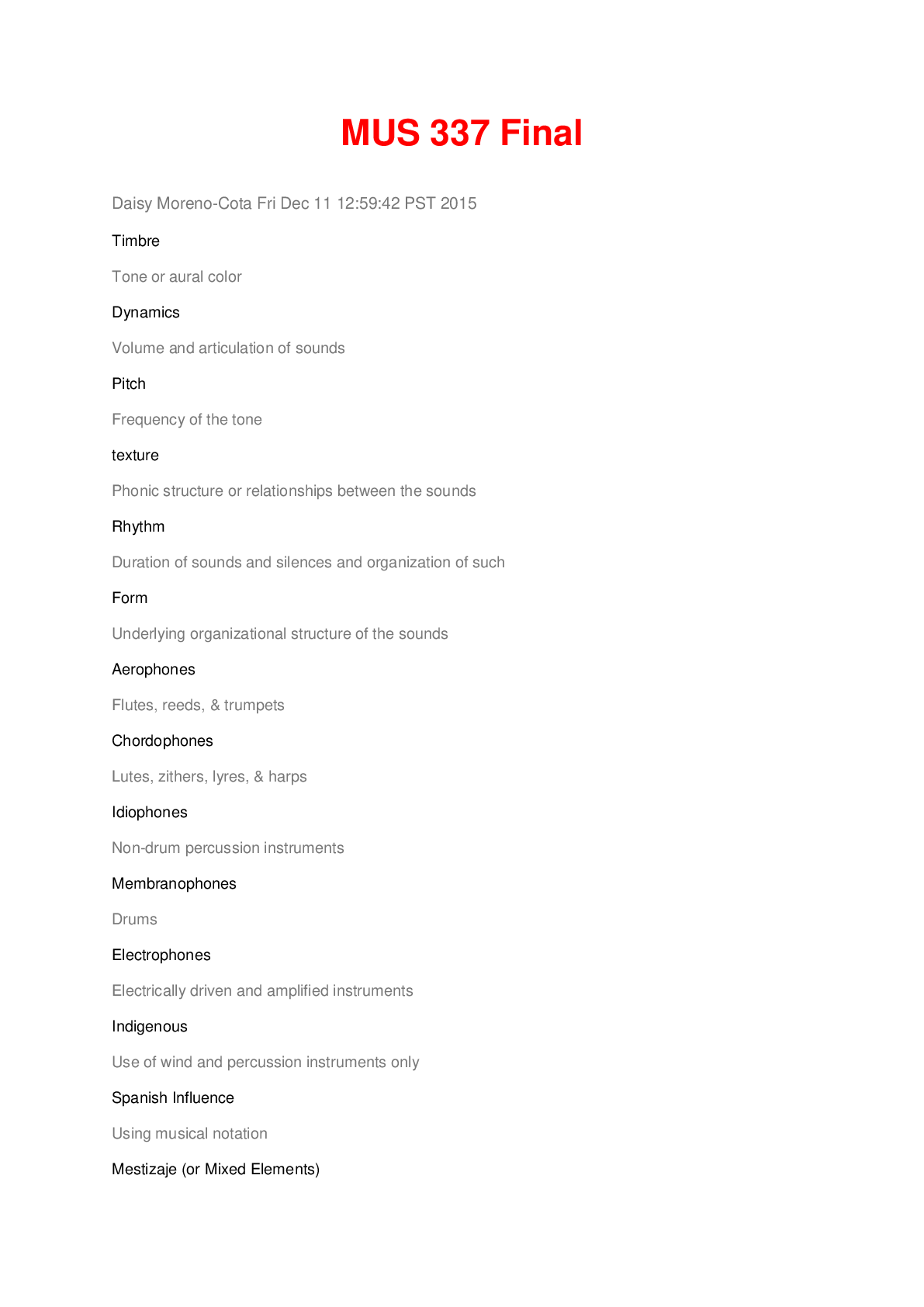




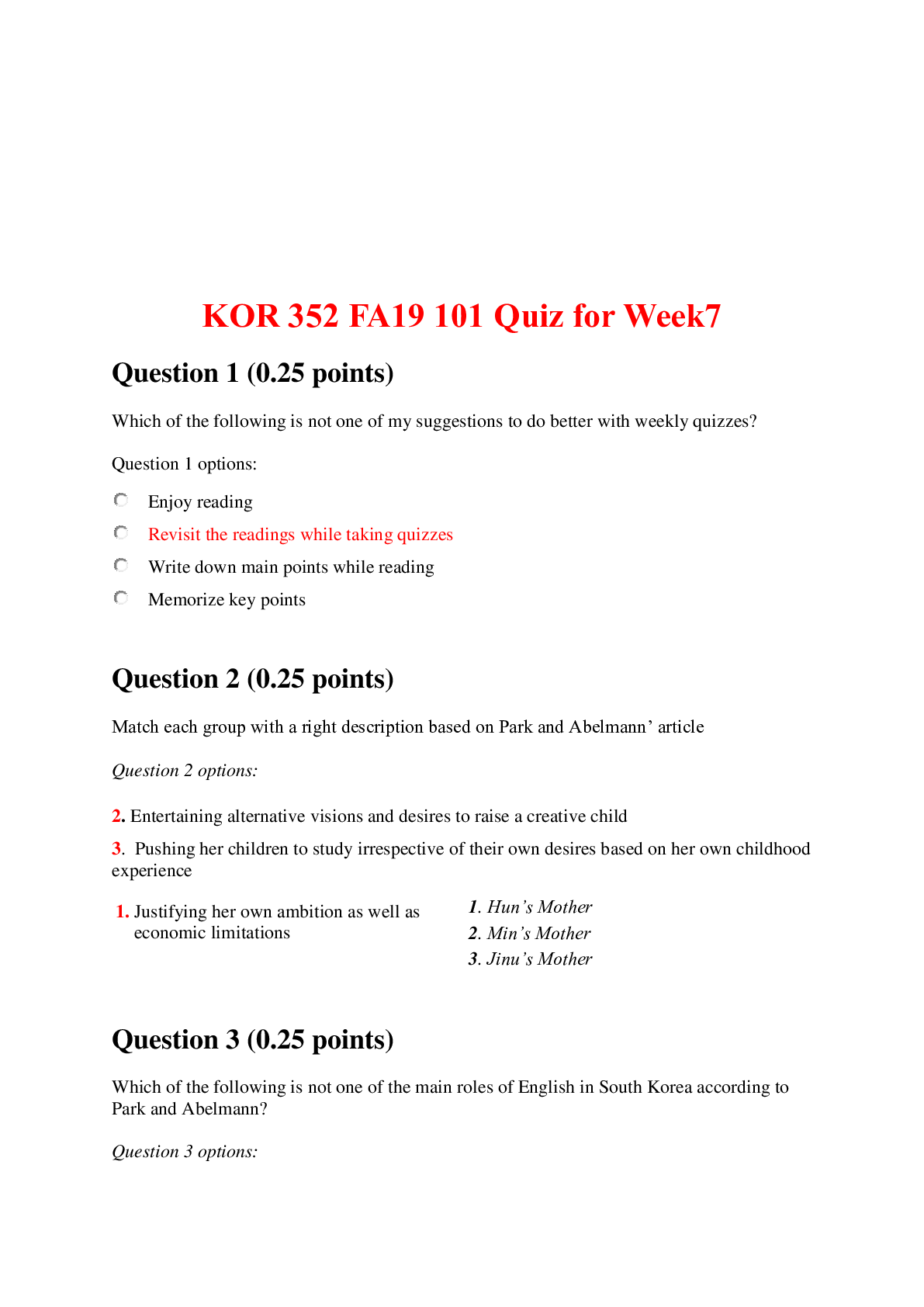


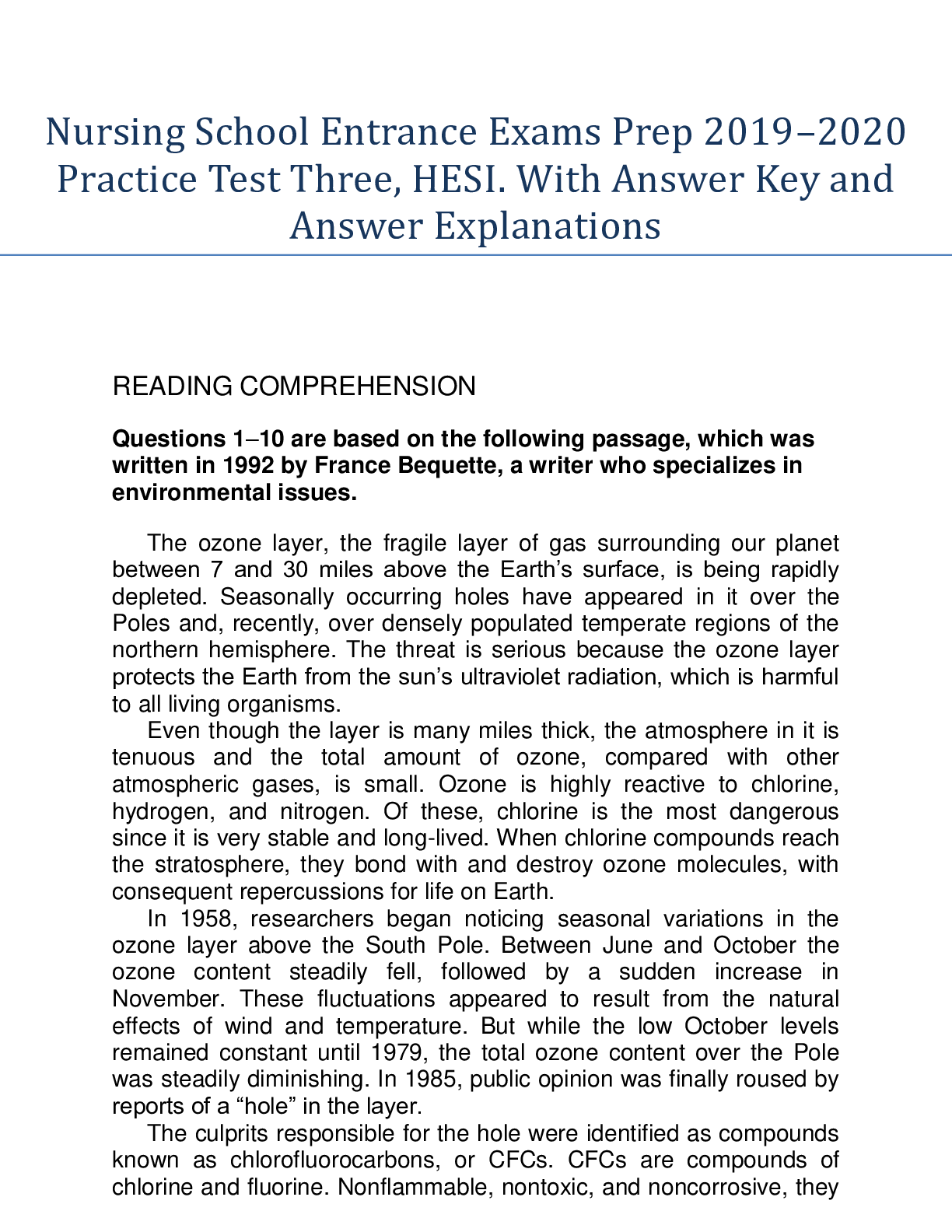
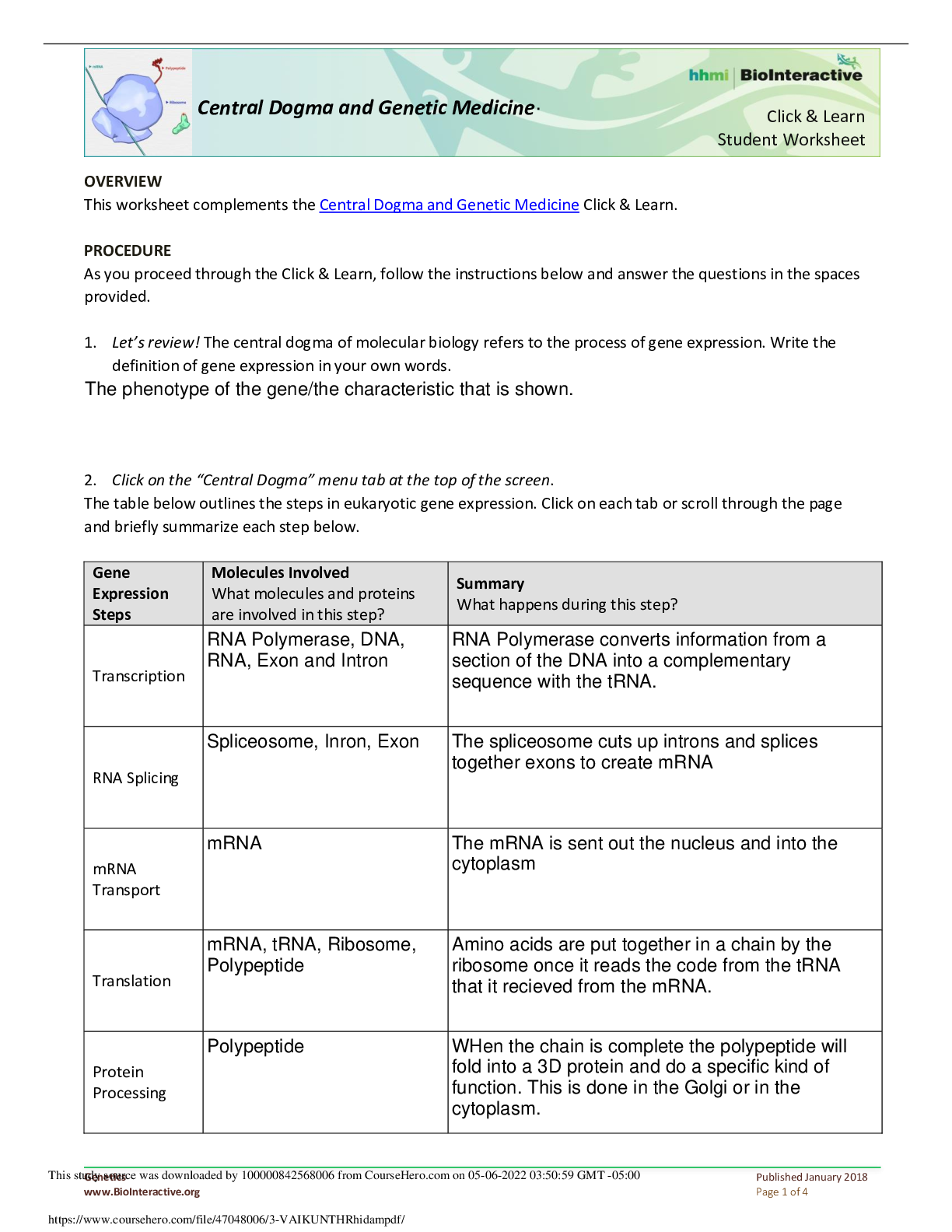
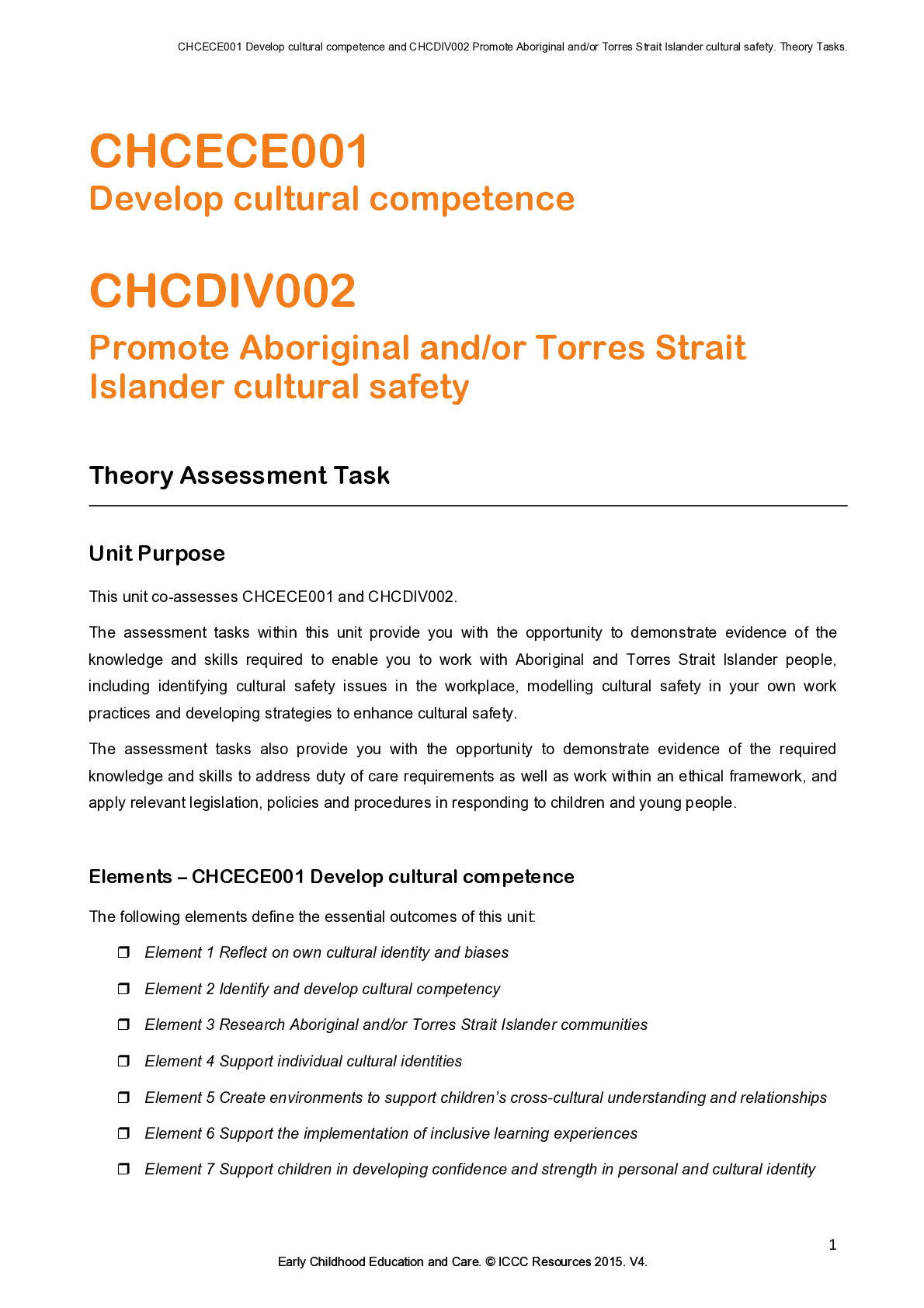
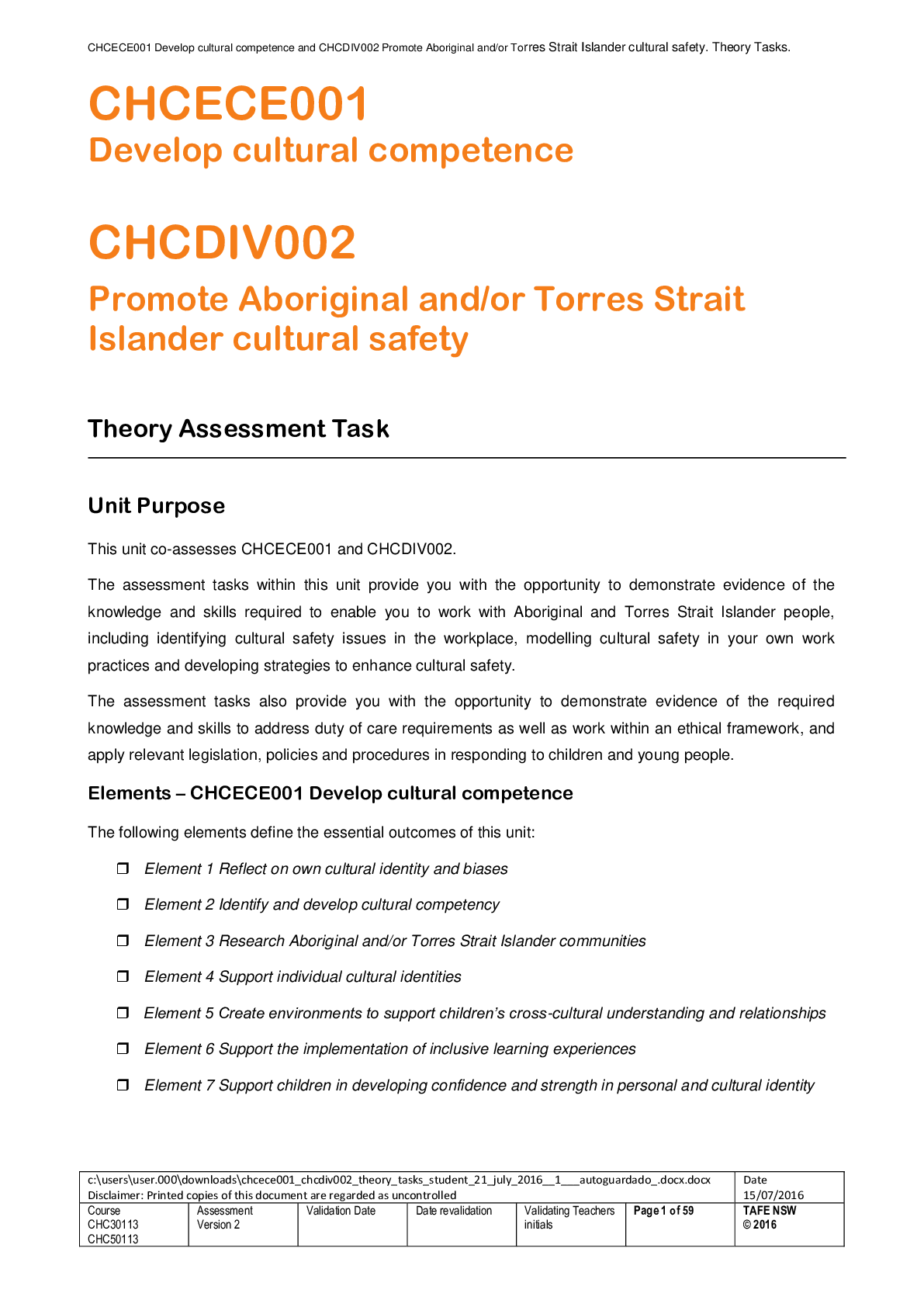
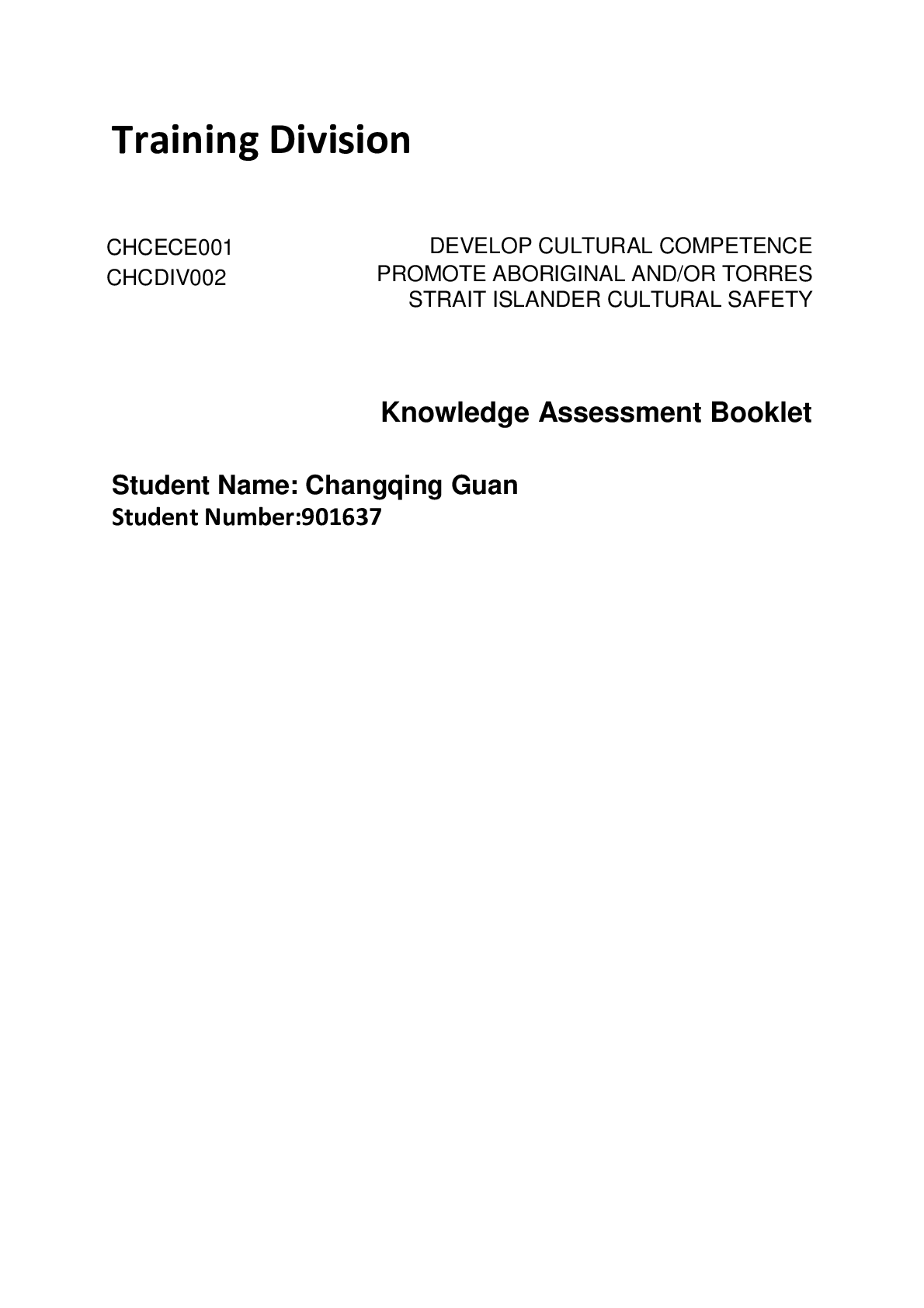


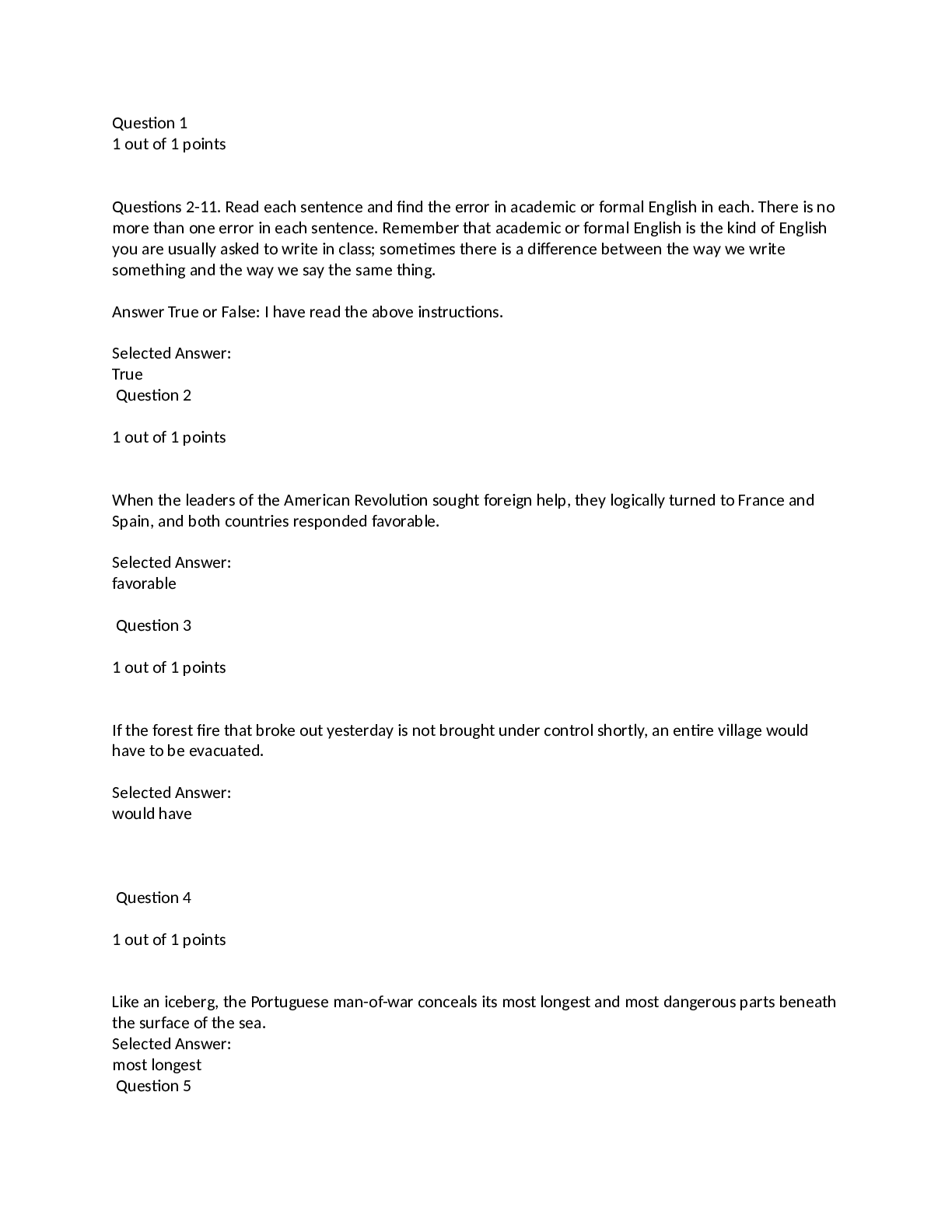
.png)
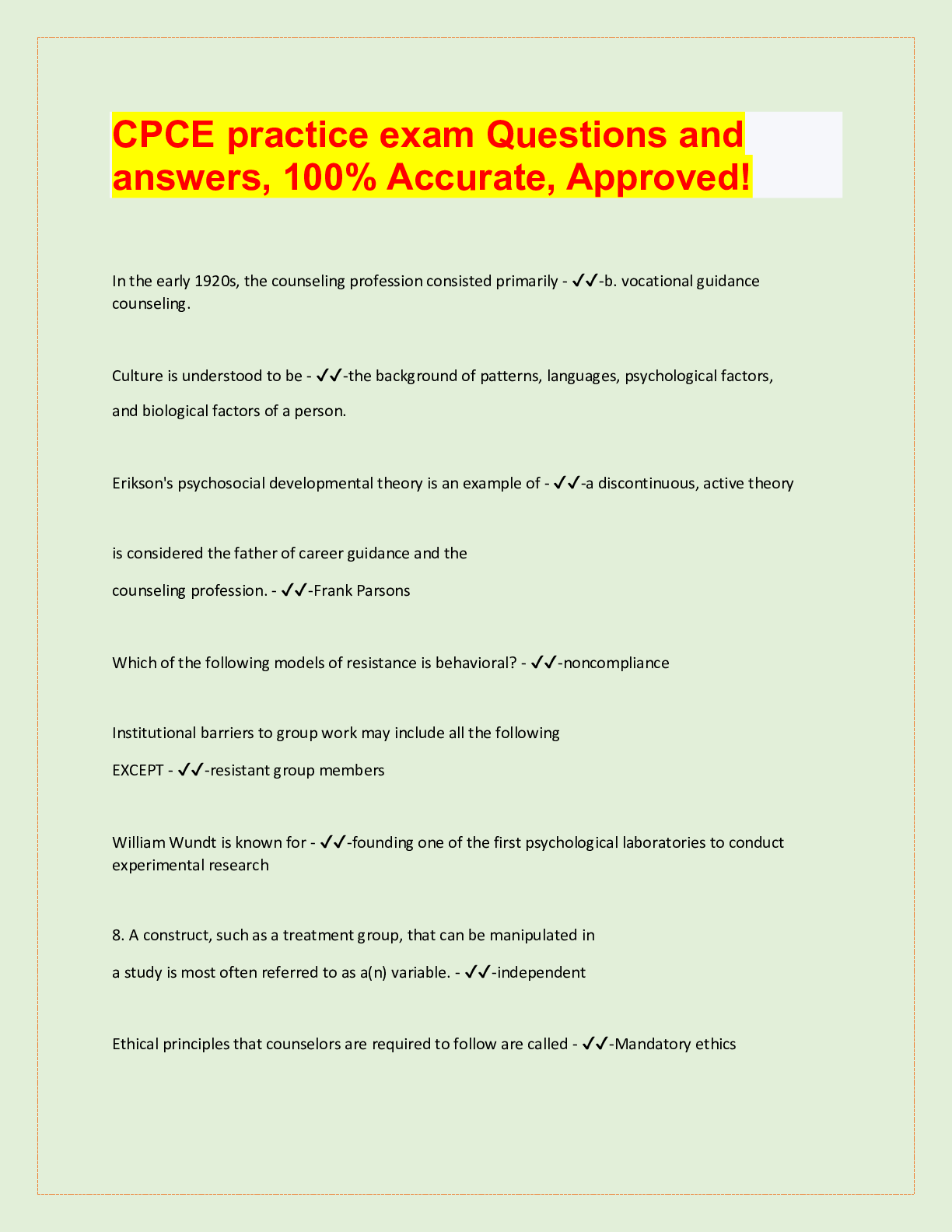
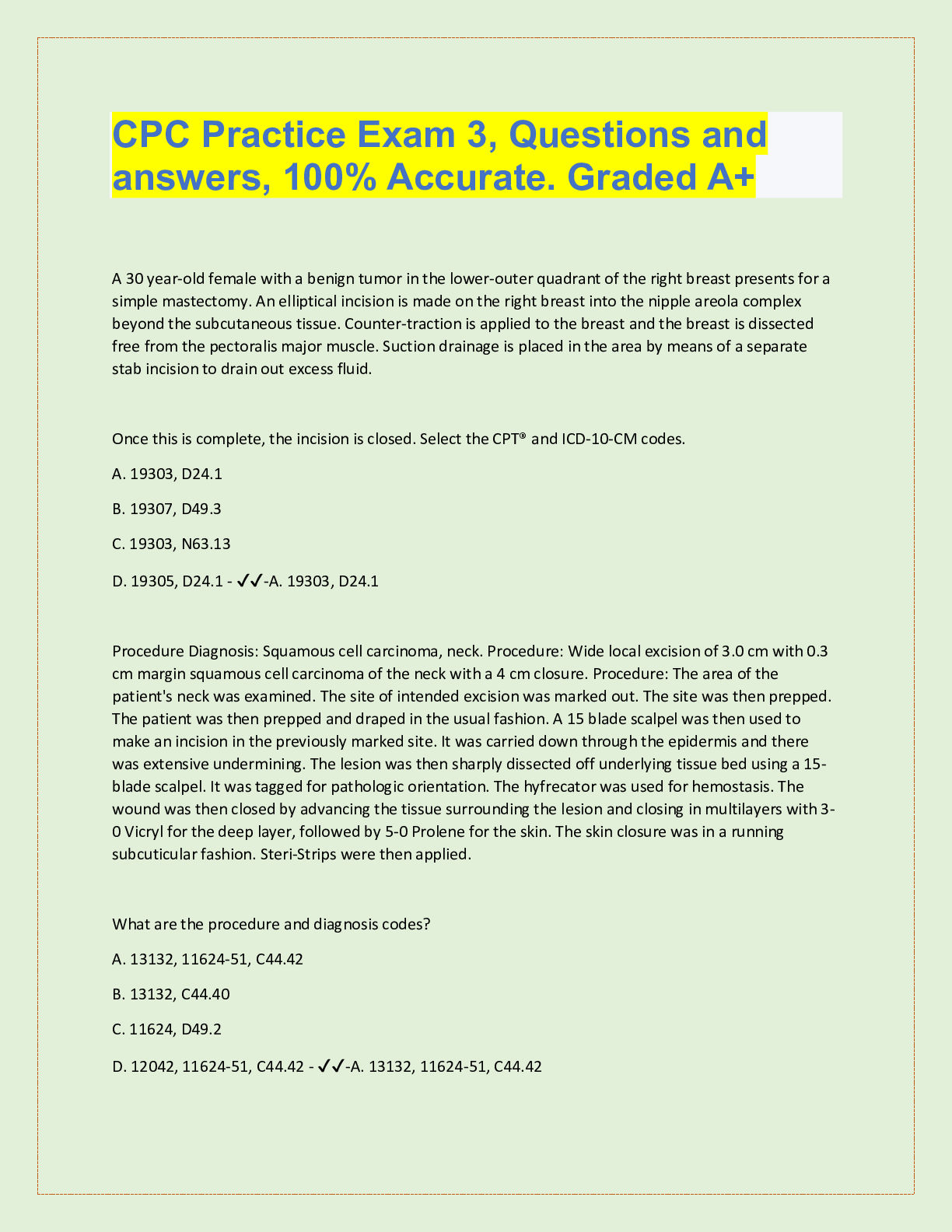
.png)

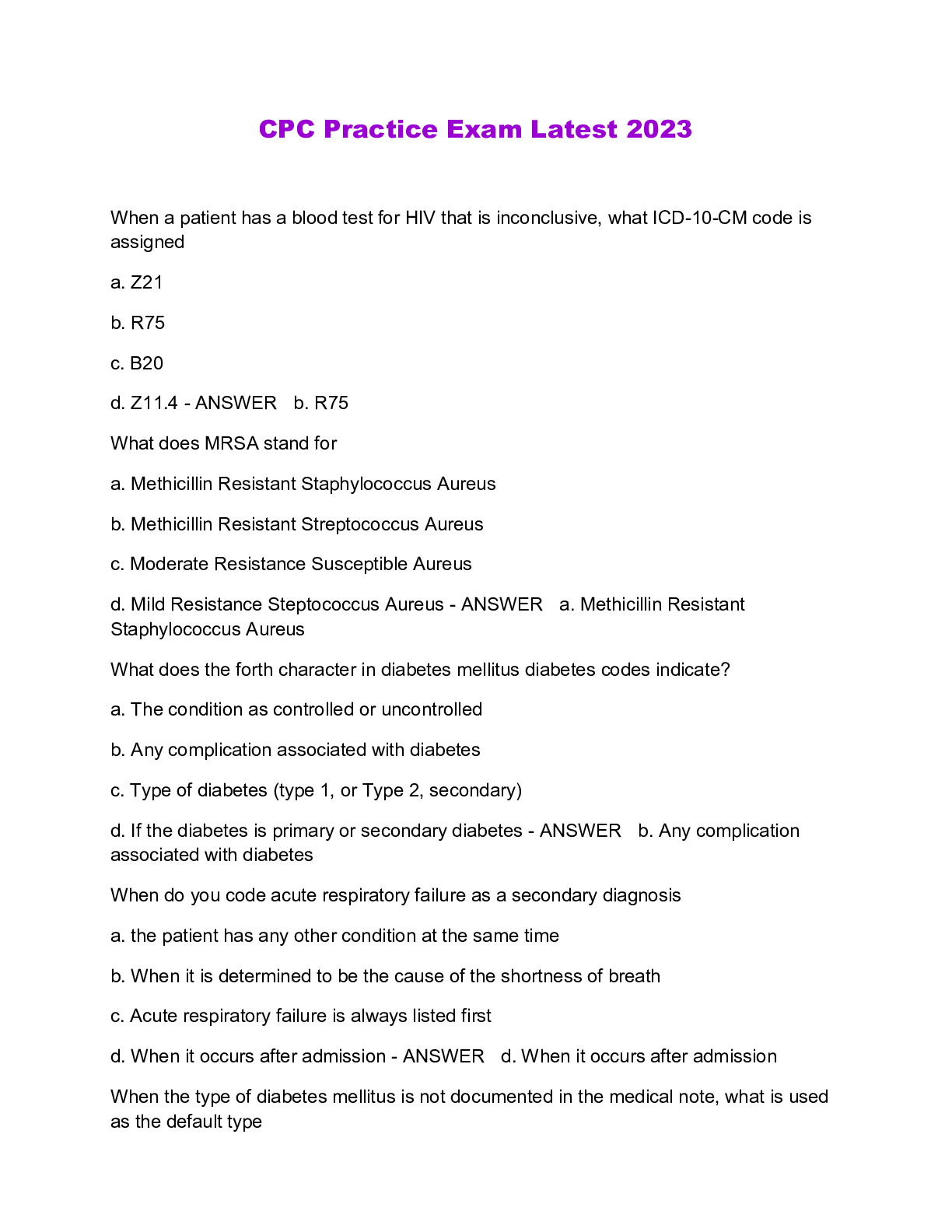
.png)


.png)

.png)

